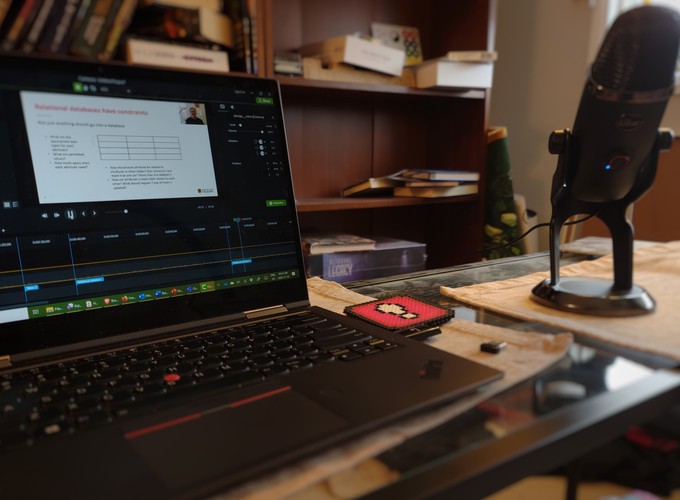It’s been a bit of a semester.
This Fall, I spent six weeks teaching DATA 604, and significantly more than six weeks designing and prepping to deliver it.
Once I was logged into Zoom for the first time, I realized that most of my plans for the semester needed rethinking. However, I managed to signficantly ramp up my video production skills (between this, and my work on the Outreach side).
My setup right now consists of:
- My laptop. It has the ability to ink which I don’t use as much as I could. It’s loaded with:
- Powerpoint. I don’t love it, but I don’t hate it.
- Camtasia. I have an older version snagged from a Humble Bundle from years past.
- XSplit VCam. I use this to fuzz my background when my software tools don’t have that capability. I find blurring the background provides a smoother viewing experience than a straight-up virtual background, so I use this when I’m in a meeting or synchronous class on Zoom as well.
- All the software we’re using in class to learn about data management in data science.
- A (Logitech) Blue Yeti X. I hadn’t meant to buy a microphone this nice, but everything cheaper was in short supply when I looked in the summer. I’m not complaining about having upgraded. It’s really nice to use.
- Logitech c922 Webcam. I mostly use the onboard webcam on my laptop, but this is good for when I need to shoot something that’s hard to position my laptop for.
- A random gaming headset (bought the night everything locked down in March). I use this if there’s too much ambient noise for the Yeti, and to monitor my audio output when I’m editing.
- My trusty clicker. It’s less noisy than when I stab at the mouse or keyboard buttons on my laptop. Also makes a great fidget toy.
- I was using an old lamp to provide lighting, which was okay. I’ve since upgraded to a LED lamp with adjustable intensity and colour I used to keep in the office.
My workflow is:
- Produce slides. This takes a lot of time, as I redesigned my course from mostly scratch (again). This time, I aimed for no more 6-7 slides, so that videos come out almost at the right length (right now, they’re still on the long side).
- Record from Powerpoint. Camtasia has an add-in for Powerpoint, which records the entire presentation as one take, instead of slide by slide. I can do this mostly in one shot now, unless I’ve completely lost the ability to use my words. I’ve learned to wait until VCam kicks in (it takes a couple of seconds), and how to put in audible artifacts so I know which audio to cut later. This usually consists of me clearly saying “Beep. Beep. Beep.”
- Edit in Camtasia. These days, this usually includes trimming a bit at the beginning and the end of the video, plus whatever audio needs a trim. I also move the inset of my head to a part of the Powerpoint where it doesn’t usually obscure any content on the slides.
Sometimes I’ll record a screencast using Camtasia when I want to illustrate how to do something with a computer, or have to splice together some video. On occasion (missing a real whiteboard or document reader badly), I’ll also record me writing on paper to show how I’ll solve a particular program. It’s a bit hard aiming the webcam but fortunately we also have a tiny smartphone tripod in the house, which also holds the webcam nicely.
Once the editing is done, I get Camtasia to render the video, keeping the quality as low as I can to keep video sizes small. Nobody has complained that they need super-high-resolution videos of a Powerpoint presentation. Then I upload it to the University’s video hosting system, Yuja, and once that’s done, embed it in a post in D2L which also contains a PDF version of the Powerpoint slides.
Overall, I’m much more comfortable with this than I used to be. I’m getting used to the sound of my voice and watching my little talking head on camera. The first set of videos each took a lot more time to record, edit, and produce, but I’ve got that time down to a minimum now. That still means four to five times the amount of time for each video than if I did them as a live lecture, between runthroughs, recording, editing, then render/upload time.
I might eventually switch to doing more video of worked examples, and experiment with different ways of presenting (I’m thinking of checking out how to build presentations in Adobe Spark), but for now this is workable, if somewhat time-consuming. The next big leap really is thinking about my pedagogical goals, and trying to figure how what I wanted to do this semester differed from what I actually did. That is another post for another day though.
